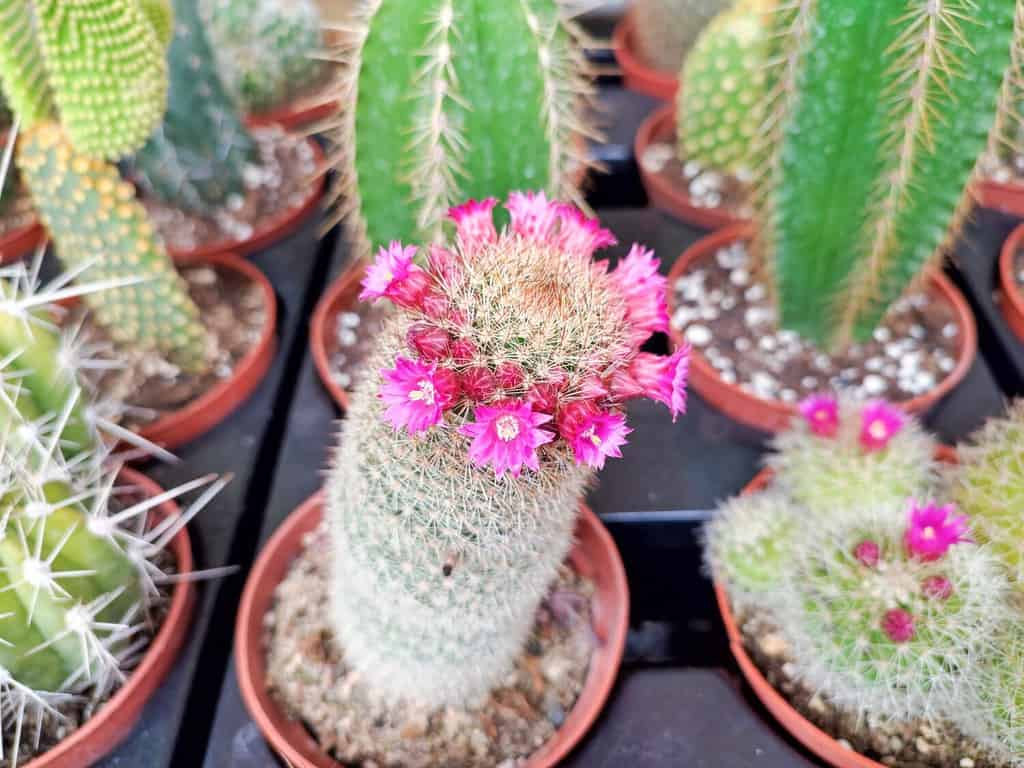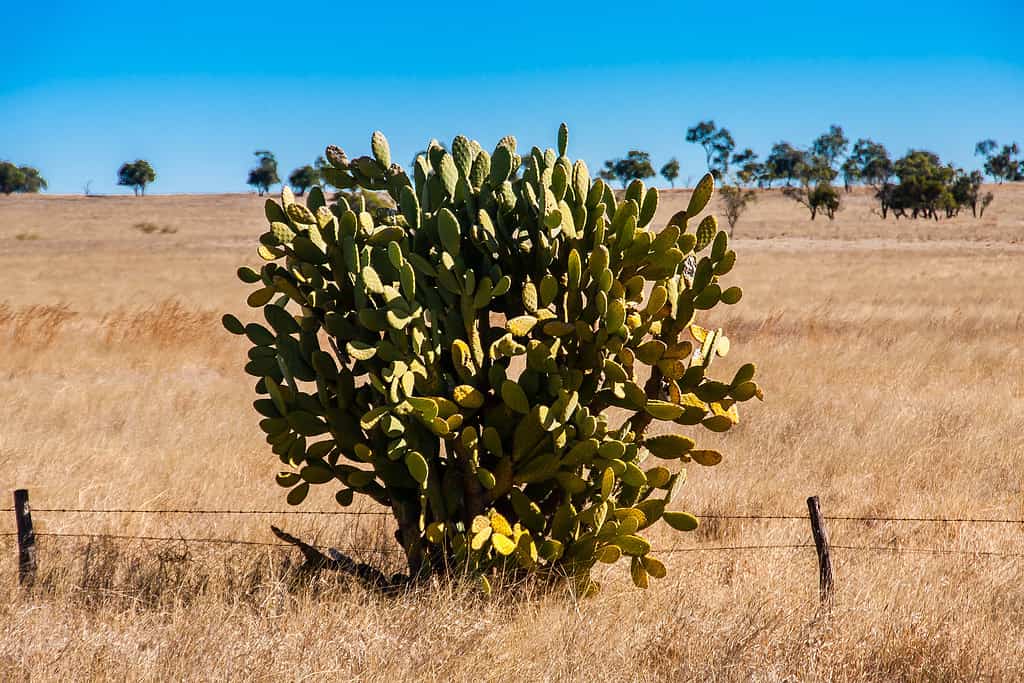No language has an unwavering set of rules, and anomalies in word usage often arise. This is especially common if words are borrowed from other languages. So, is it cacti or cactuses? Which plural form of cactus is correct?
The Etymology of Cactus: Where Does the Word Come From?

The word cactus is a Latin word derived from the Ancient Greek word kaktos.
©The_AA’s/Shutterstock.com
An Ancient Greek philosopher named Theophrastus coined the word kaktos to describe a plant with spines. However, no one is sure which plant he was describing. This word was co-opted by the Romans and became cactus in Latin.
The history of the word cactus gets murky at this point as most history of language does after the fall of the Roman Empire. However, as Vulgar Latin became the various Romance Languages, cactus somehow survived until it resurfaced at the end of the Middle Ages.
Because of its roots in Latin, in today’s world, the word cactus is used in Spanish, Italian, Romanian, and French. In Portuguese, it’s cacto, which is sometimes also used in Spanish.
Around 1600, the word cactus may have sprung into use to describe a cardoon (Cynara cardunculus). A cardoon is a prickly plant that’s also called an artichoke thistle though it isn’t an artichoke.
The word cactus traveled to America and changed in meaning as people entered the American Southwest. Then, it began to be used in its modern sense around 1738. The word was officially recorded by the English in 1769.
Cacti or Cactuses: Which Plural Form is Correct?
Both cacti and cactuses are technically correct. Cacti is the pluralization of cactus in Latin, and the word cactuses is the pluralization according to standard rules for the English language. You’ll hear people say cacti more often, but both are grammatically correct.
Scientists are familiar with Latin because it’s used when creating scientific names. As a result, its use bleeds into fields like botany and zoology. This tendency of scientists to use cacti trickles down into the everyday vernacular.
However, the word cactuses is gaining popularity in everyday speech because Latin is no longer a required requisite for those studying science in universities. In the 1960s, universities slowly started changing their Latin language requirements as a way to encourage students to learn other common foreign languages. This means that many educators now default to the English ending instead of Latin as familiarity with Latin wanes.
Isn’t the Word Cactus Also Plural As Is?
Yes, using the word cactus when denoting two or more cactus plants is also correct. This is most commonly heard among American English speakers.
While grammar enthusiasts will insist that using cactus as a plural is incorrect, in the common vernacular, it is a valid use of the word. Languages evolve, and this is one of those instances where broken rules aren’t so broken that the usage is incorrect.
Since cactus already ends with an s, some continue to use the unaltered word for the plural form as the s is interpreted as a good enough demarcation that multiple plants are being described. In these cases, word agreements like was/were, have/had, and others are what define the word as singular or plural.
What Does Cactus Mean in Australian Slang?

The word cactus in Australia is slang for defeated, beat down, or finished.
©vdvornyk/iStock via Getty Images
When someone in Australia uses the word cactus, they may mean that something is broken or has died. If a car can’t be fixed even though a mechanic worked on it, that car is cactus. Colloquialisms in the United States like Kicked the Bucket or Keeled Over equate to the use of cactus by Australians.
It’s usually a common euphemism used by normal working-class people in place of an expletive. This is a common mechanism in most languages since taboo words are so descriptive yet highly inappropriate in certain contexts.
The exact history of the Australian use of cactus as slang is murky, but there are a few theories. One prevailing theory is centered on the prickly pear cactus (Opuntia) that is invasive in Australia.
It’s believed that the prickly pear was brought to Australia on the First Fleet in 1788. It spread too quickly and became a destructive invasive species. In the 1920s, the cactus moth (Cactoblastis cactorum) was introduced to combat the prickly pear invasion.
The cactus moth did an outstanding job and almost eliminated the prickly pear invasion in a handful of years. There are no native cacti in Australia, and the prickly pear was demolished. It’s logical to assume that the defeat, finishing, beating down, or ruining of the prickly pear applied its demise to the word in a general sense over the next few generations.
What is the Indigenous Word for Cactus?

The saguaro cactus is called Ha:sañ by the Tohono O’odham of Arizona and Mexico.
©iStock.com/Nate Hovee
Since cacti were endemic to North and South America before colonization, the original words for these plants were not rooted in Latin. As a result, these original names sound nothing like the word cactus.
A lot of the words used to describe cacti in the historical Mexican range originate from the Nahuatl language. In Mexico, the prickly pear is a cultural icon and its importance in the region dates back to at least the Aztecs. The term nopales in Spanish, defined as the edible paddles of the prickly pear, derives from the Nahuatl word nohpalli.
Tenochtitlàn, which is the ancient Aztec city that Mexico City is now centered on, is roughly translated from Nahuatl to Place of the Prickly Pear Cactus Rocks. Nōchtli means prickly pear, tetl means rock, and tlan denotes that something is a place.
In the Caribbean where the prickly pear also grows, prickly pear fruits are known as tuna in Taino languages. In some Spanish-speaking regions, this term is also used. The use of the word tuna in this context has a completely separate etymology from the same word used when referencing tuna fish.
The large saguaro cactus (Carnegiea gigantea) of the Sonoran Desert in Arizona and Mexico is iconic. The Tohono O’odham, or the People of the Desert, are the indigenous culture native to the region. They call the saguaro Ha:sañ which has an anglicized pronunciation of Ha shan.
The fruit from a saguaro in the Tohono O’odham language is called b’ahi:daj. This is pronounced as Bah-hee thutch. These fruits are a life source for desert humans and animals alike, and they’re ready to be harvested from the middle of June through the end of July.
The photo featured at the top of this post is © Kanjana Wattanakungchai/Shutterstock.com
Thank you for reading! Have some feedback for us? Contact the AZ Animals editorial team.







